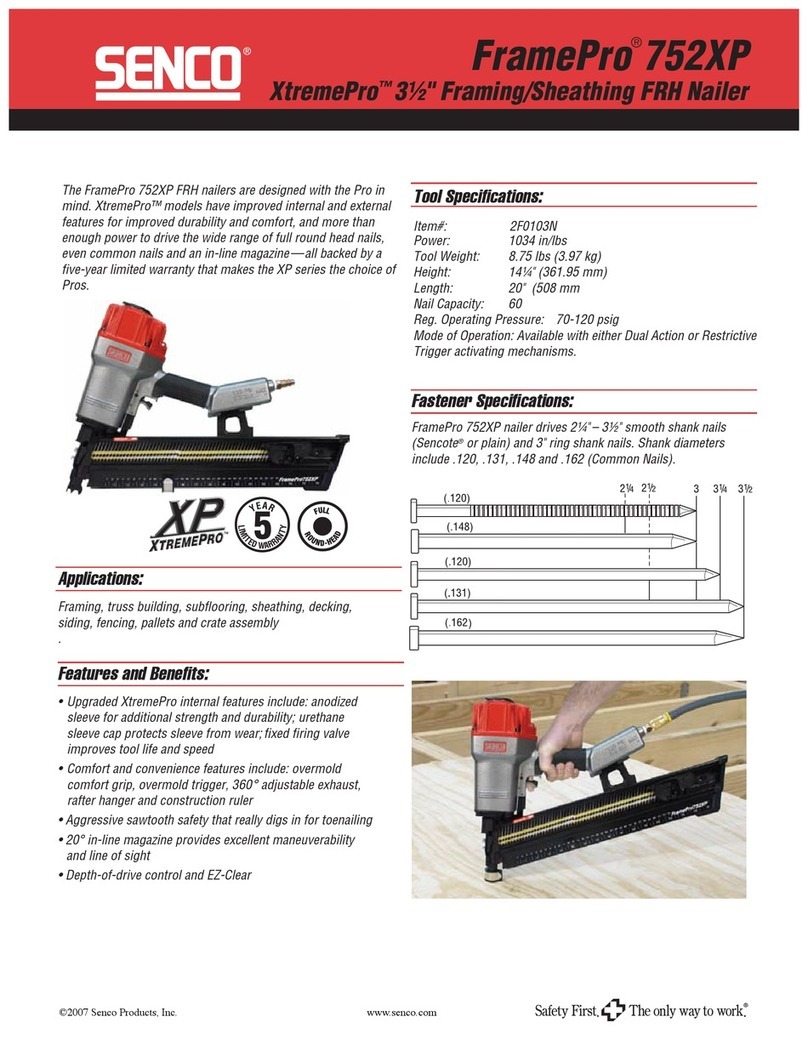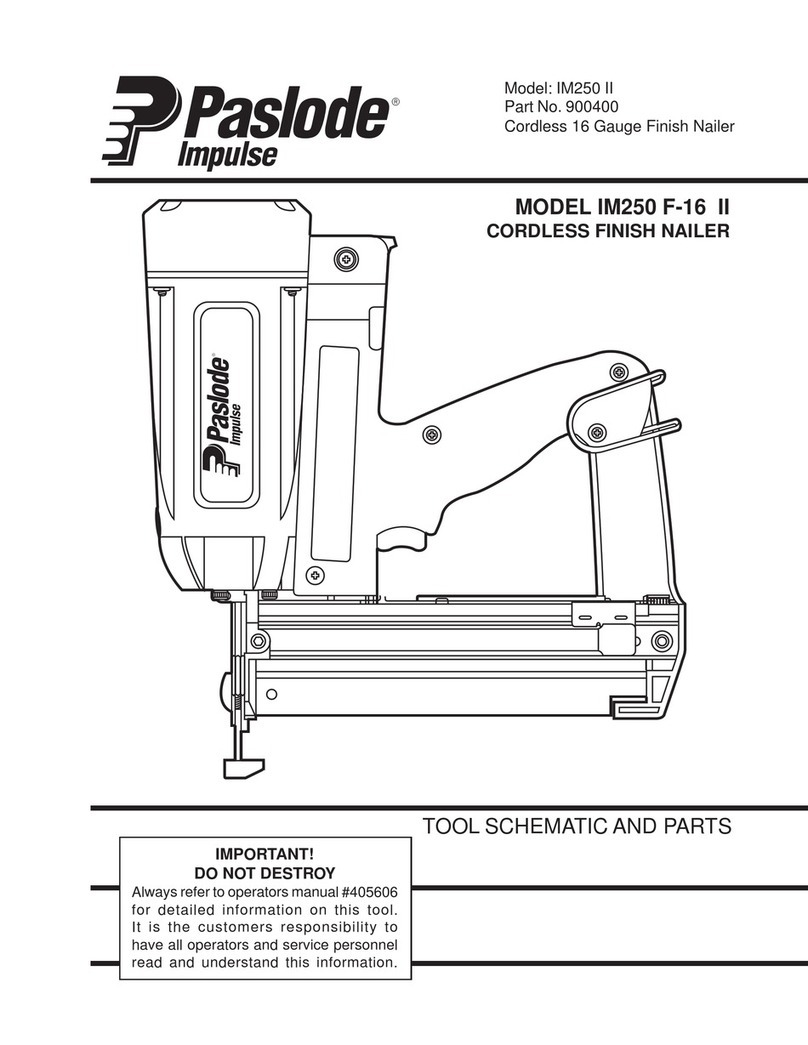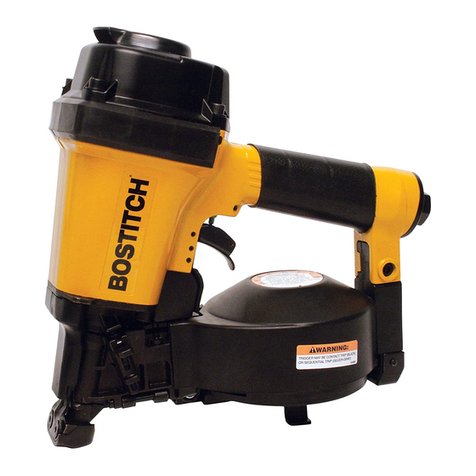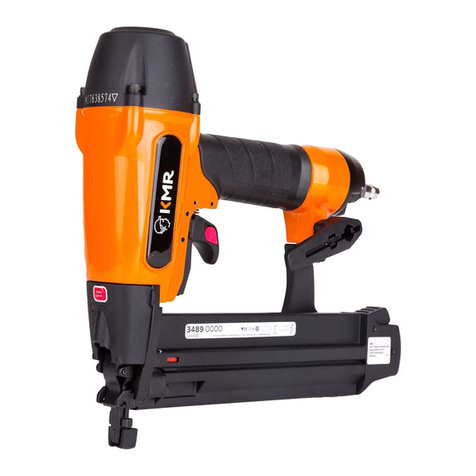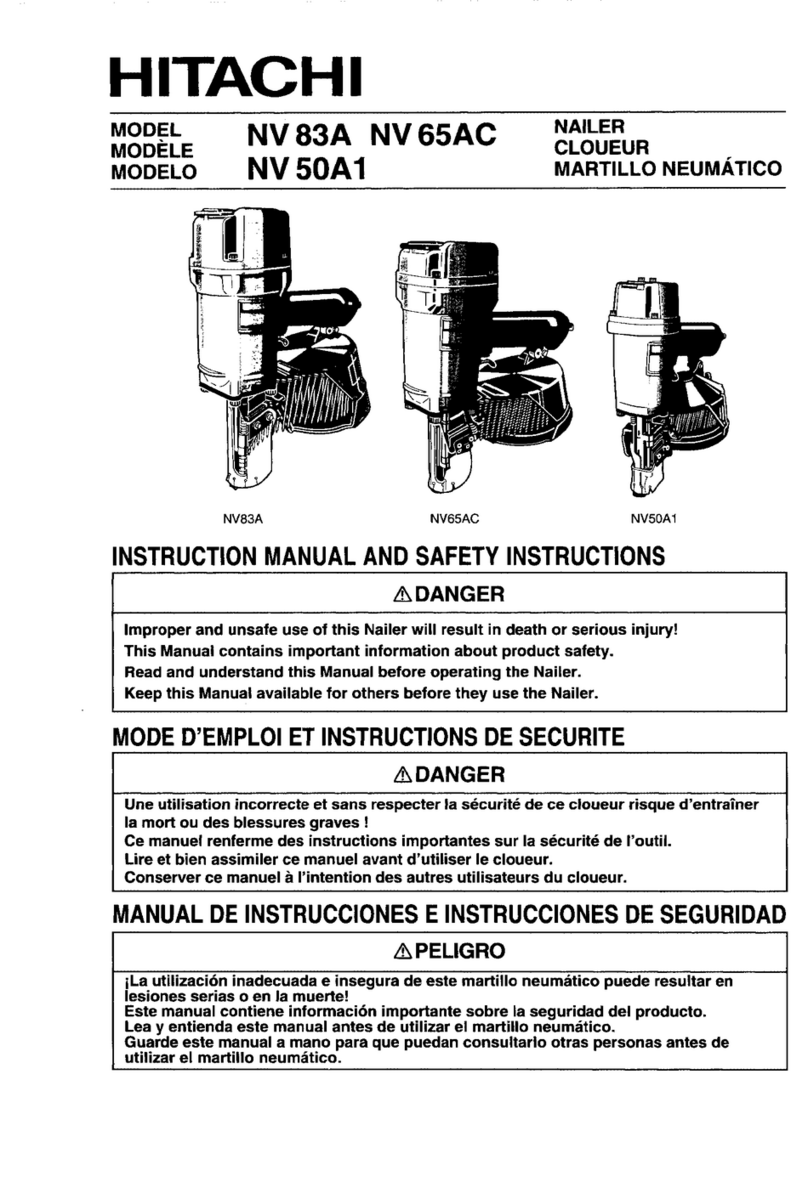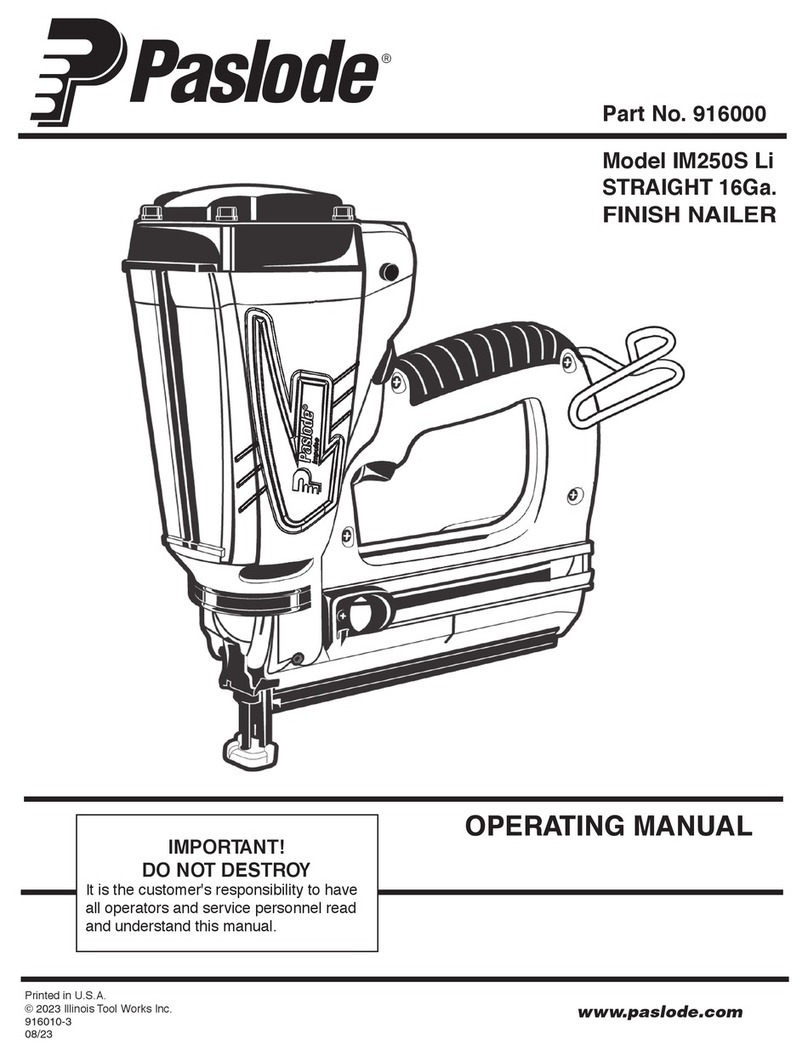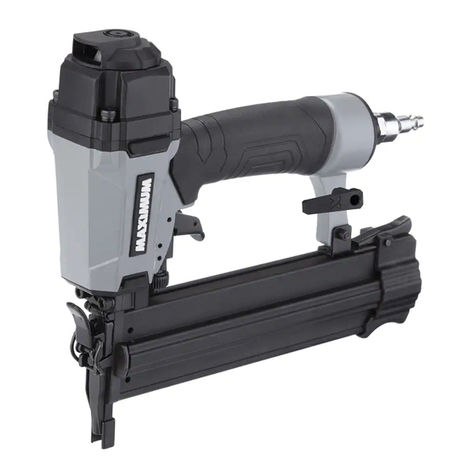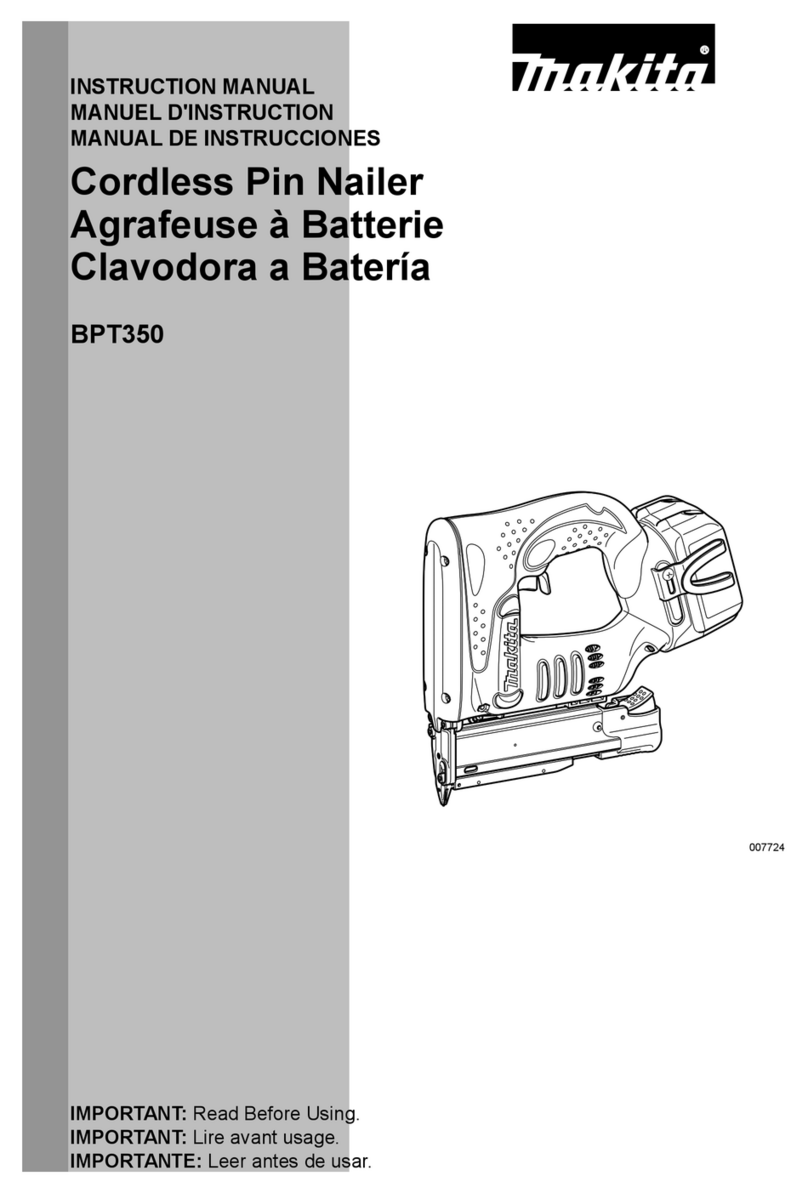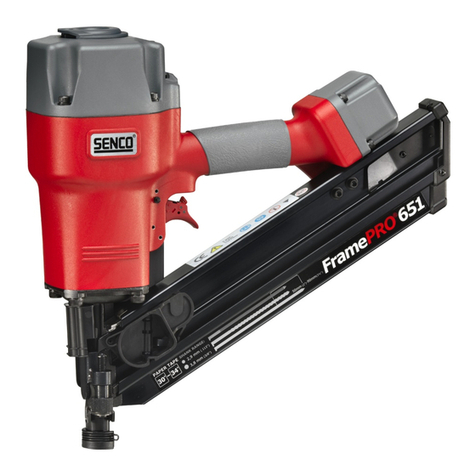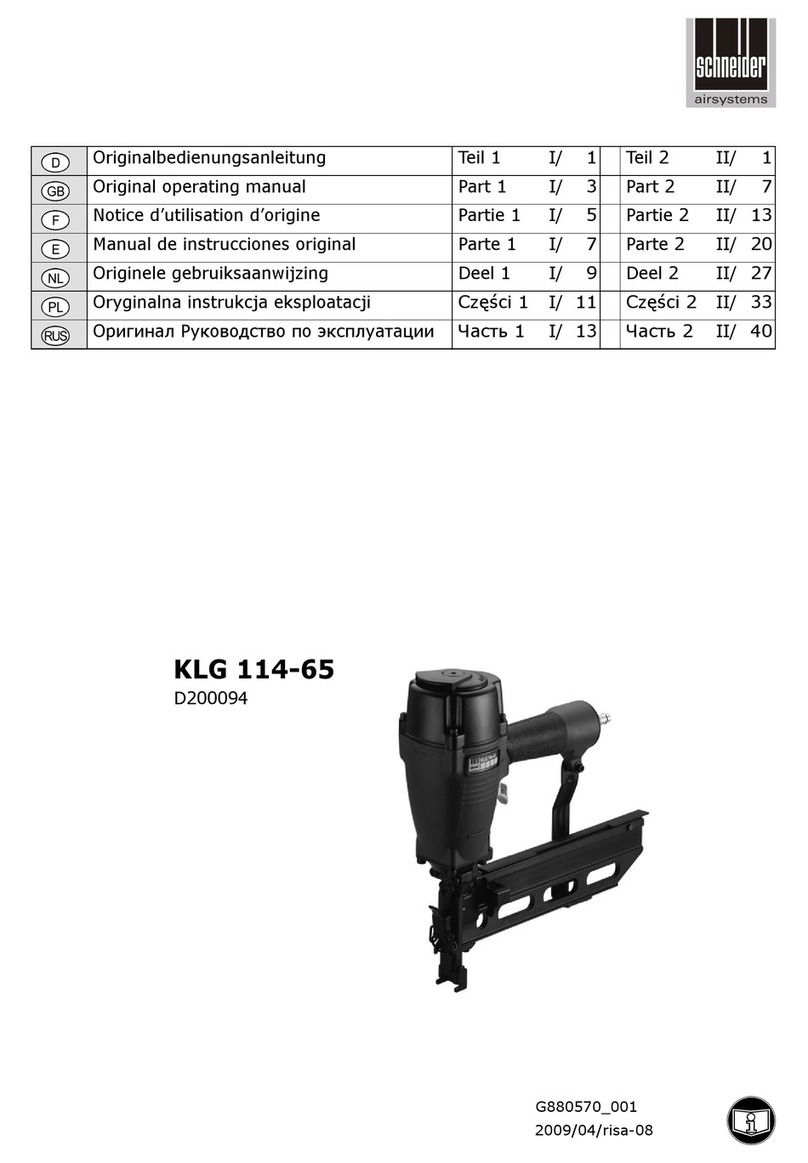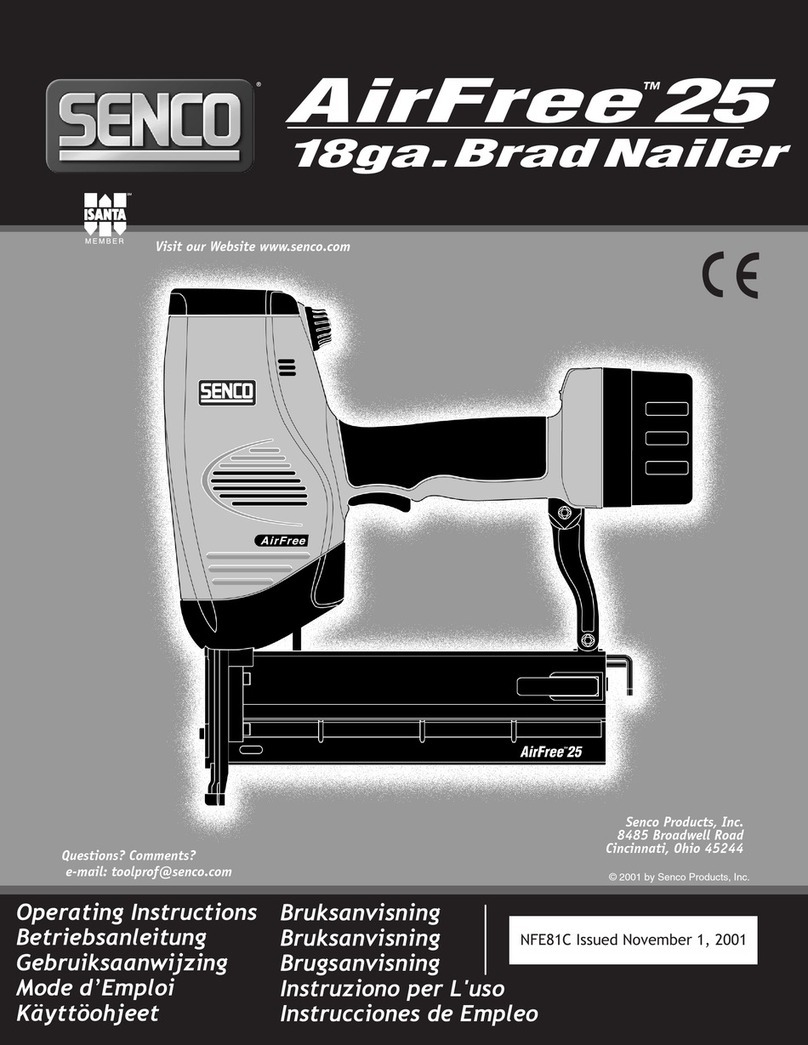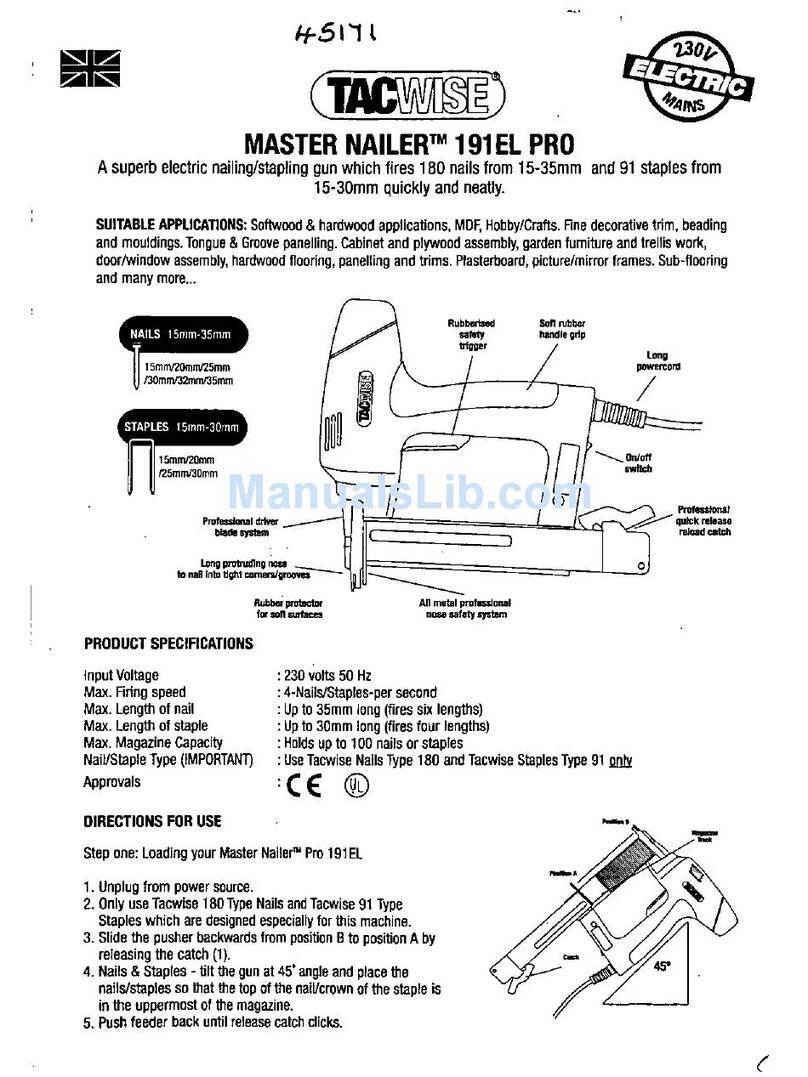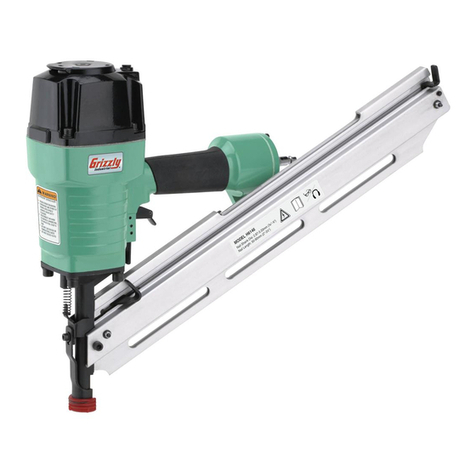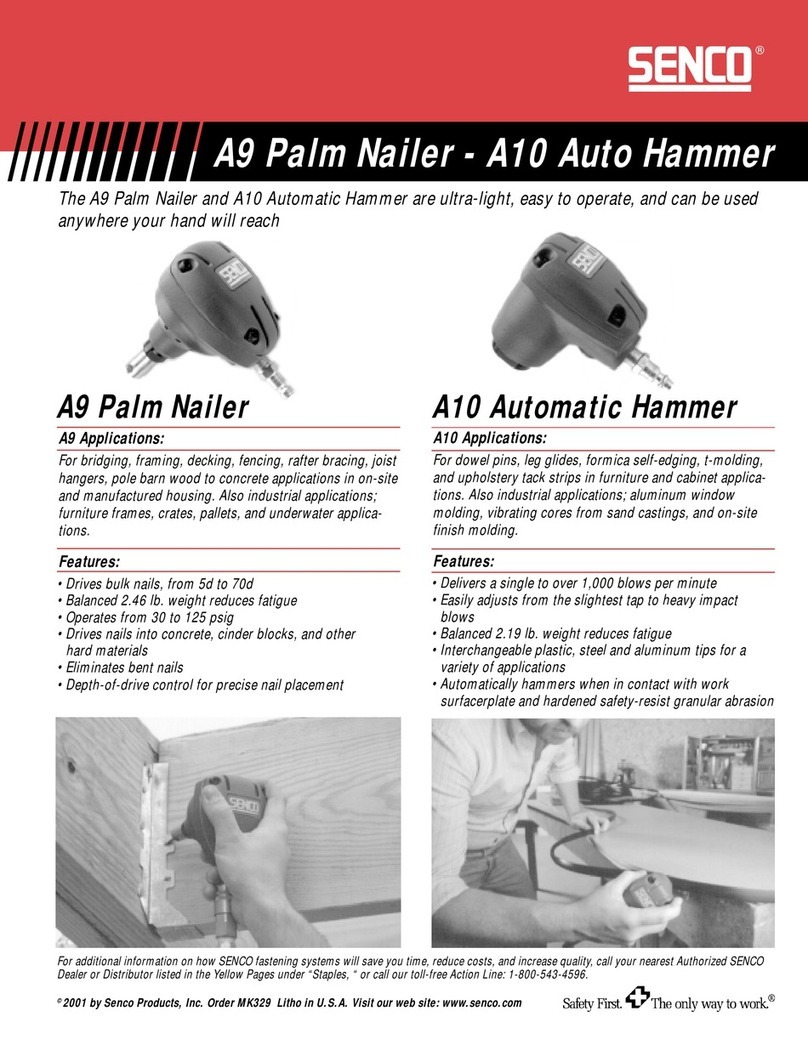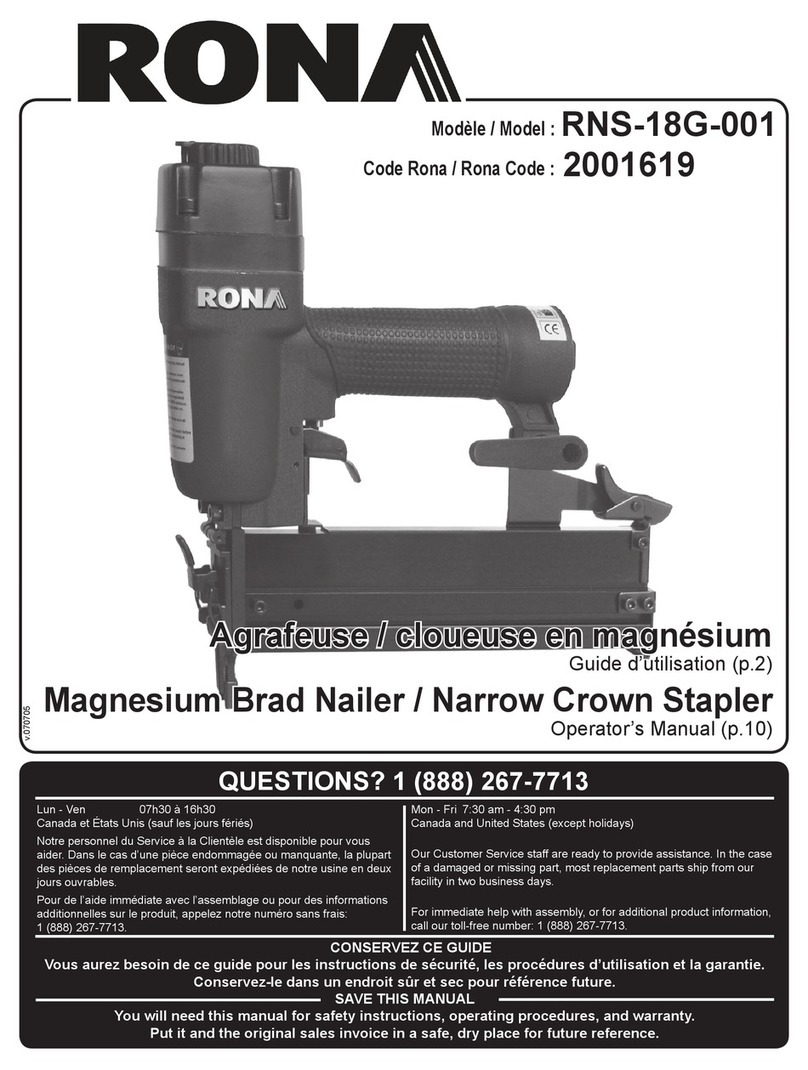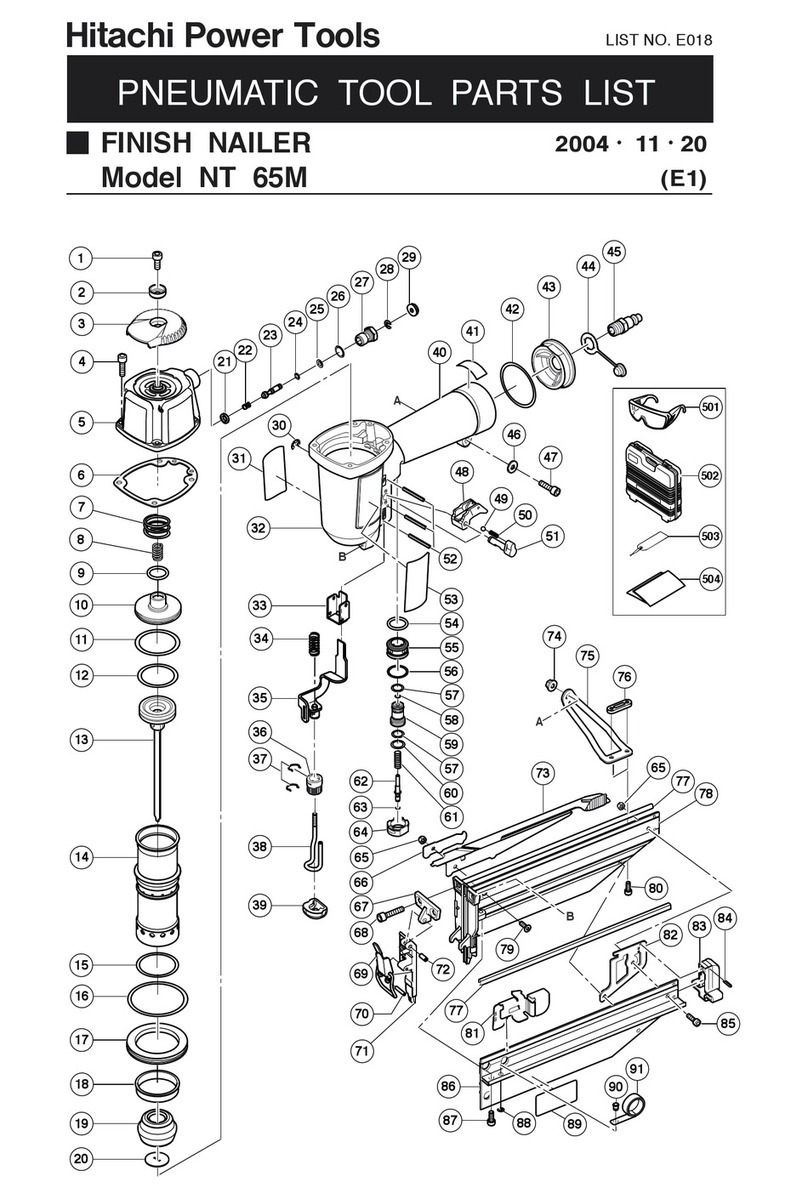Stan-Tech SDN11PTB User manual

SDN11PTB
PNEUMATIC STICK NAILER
103127REVB 3/98
OPERATION and MAINTENANCE MANUAL
BEFORE OPERATING THIS TOOL, ALL OPERATORS SHOULD STUDY THIS MANUAL, TO UNDERSTAND
AND FOLLOW THE SAFETY WARNINGS AND INSTRUCTIONS. KEEP THESE INSTRUCTIONS WITH THE
TOOL FOR FUTURE REFERENCE. IF YOU HAVE ANY QUESTIONS, CONTACT YOUR STAN-TECH
REPRESENTATIVE OR DISTRIBUTOR.

Stan-Tech tools have been engineered to provide excellent customer satisfaction and are designed to achieve
maximum performance when used with precision Stan-Tech fasteners engineered to the same exacting standards.
Stan-Tech cannot assume responsibility for product performance if our tools are used with fasteners or
accessories not meeting the specific requirements established for genuine Stan-Tech nails, staples and
accessories.
INTRODUCTION
INDEX
NOTE:
LIMITED WARRANTY
The Stan-Tech SDN11PTB series stick nailer tools are precision-built tools, designed for high speed, high volume
fastening. These tools will deliver efficient, dependable service when used correctly and with care. As with any fine
power tool, for best performance the manufacturer’s instructions must be followed. Please study this manual before
operating the tool and understand the safety warnings and cautions. The instructions on installation, operation and
maintnance should be read carefully, and the manuals kept for reference.
NOTE: Additional safety measures may be required because of your particular application of the tool.
Contact your Stan-Tech representative or distributor with any questions concerning the tool and its use.
Safety Instructions . . . . . . . . . . . . . . . . . . . . . . . . . . . . . . . . . . . . . . . . . . . . . . . . . . . . . . . . . . . 3
Basic Tool Operation . . . . . . . . . . . . . . . . . . . . . . . . . . . . . . . . . . . . . . . . . . . . . . . . . . . . . . . . . 4
Operating the Tool . . . . . . . . . . . . . . . . . . . . . . . . . . . . . . . . . . . . . . . . . . . . . . . . . . . . . . . . . . . 6
Trouble Shooting . . . . . . . . . . . . . . . . . . . . . . . . . . . . . . . . . . . . . . . . . . . . . . . . . . . . . . . . . . . . 7
Air Supply: Fittings, Hoses, Filters, Air Consumption, Regulators,
Operating Pressure, Setting Correct Pressure . . . . . . . . . . . . . . . . . . . . . . . . . . . . . . . . . . . 8
Lubrication . . . . . . . . . . . . . . . . . . . . . . . . . . . . . . . . . . . . . . . . . . . . . . . . . . . . . . . . . . . . . . . . 8
Maintaining the Pneumatic Tool . . . . . . . . . . . . . . . . . . . . . . . . . . . . . . . . . . . . . . . . . . . . . . . . . 9
Tool Specifications . . . . . . . . . . . . . . . . . . . . . . . . . . . . . . . . . . . . . . . . . . . . . . . . . . . . . . . . . . . 9
Loading the Tool. . . . . . . . . . . . . . . . . . . . . . . . . . . . . . . . . . . . . . . . . . . . . . . . . . . . . . . . . . . . . 10
Fastener Depth Control . . . . . . . . . . . . . . . . . . . . . . . . . . . . . . . . . . . . . . . . . . . . . . . . . . . . . . . 10
Directional Exhaust. . . . . . . . . . . . . . . . . . . . . . . . . . . . . . . . . . . . . . . . . . . . . . . . . . . . . . . . . . . 10
Driver Length & Adjustment . . . . . . . . . . . . . . . . . . . . . . . . . . . . . . . . . . . . . . . . . . . . . . . . . . . 11
Stan-Tech, warrants to the original retail purchaser that this product is free from defects in material and workmanship,
and agrees to repair or replace, at Stan-Tech’s option, any defective product within 90 days from the date of purchase.
This warranty is not transferable. It only covers damage resulting from defects in material or workmanship, and it does
not cover conditions or malfunctions resulting from normal wear, neglect, abuse or accident.
THIS WARRANTY IS IN LIEU OF ALL OTHER EXPRESS WARRANTIES. ANY WARRANTY OF MERCHANTABILITY
OR FITNESS FOR A PARTICULAR PURPOSE IS LIMITED TO THE DURATION OF THIS WARRANTY. STAN-TECH
SHALL NOT BE LIABLE FOR ANY INCIDENTAL OR CONSEQUENTIAL DAMAGES.
Some states do not allow limitations on how long an implied warranty lasts, or the exclusion or limitation of incidental or
consequential damages, so the above limitations or exclusions may not apply to you. This warranty gives you specific
legal rights, and you may also have other rights which vary from state to state.
To obtain warranty service, you must return the product at your expense together with proof of purchase to a
STAN-TECH Regional warranty repair center or you may call us at 1-800-343-1234 for the location of additional
authorized warranty service locations in your area.
-2-

SAFETY INSTRUCTIONS
AIR SUPPLY AND CONNECTIONS
LOADING TOOL
OPERATION
MAINTAINING THE TOOL
EYE PROTECTION which conforms to ANSI specifications and provides protection against flying
particles both from the FRONT and SIDE should ALWAYS be worn by the operator and others in the
work area when loading, operating or servicing this tool. Eye protection is required to guard
against flying fasteners and debris, which could cause severe eye injury.
The employer and/or user must ensure that proper eye protection is worn. Eye protection
equipment must conform to the requirements of the American National Standards Institute, ANSI
Z87.1-1989 and provide both frontal and side protection. NOTE: Non-side shielded spectacles and
face shields alone do not provide adequate protection.
CAUTION: ADDITIONAL SAFETY PROTECTION will be required in some environments. For example,
the working area may include exposure to noise level which can lead to hearing damage. The
employer and user must ensure that any necessary hearing protection is provided and used by the
operator and others in the work area. Some environments will require the use of head protection
equipment. When required, the employer and user must ensure that head protection conforming to
ANSI Z89.1 1986 is used.
Do not use oxygen, combustible gases, or bottled gases as a power source for this tool
as tool may explode, possibly causing injury.
Do not use supply sources which can potentially exceed 200 P.S.I.G. as tool may burst,
possibly causing injury.
The connector on the tool must not hold pressure when air supply is disconnected. If a
wrong fitting is used, the tool can remain charged with air after disconnecting and thus
will be able to drive a fastener even after the air line is disconnected possibly causing
injury.
Do not pull trigger or depress contact arm while connected to the air supply as the tool
may cycle, possibly causing injury.
Always disconnect air supply: 1.) Before making adjustments; 2.) When servicing the tool;
3.) When clearing a jam; 4.) When tool is not in use; 5.) When moving to a different work
area, as accidental actuation may occur, possibly causing injury.
When loading tool: 1.) Never place a hand or any part of body in fastener discharge area
of tool; 2.) Never point tool at anyone; 3.) Do not pull the trigger or depress the trip as
accidental actuation may occur, possibly causing injury.
Always handle the tool with care: 1.) Never engage in horseplay; 2.) Never pull the
trigger unless nose is directed toward the work; 3.) Keep others a safe distance from the
tool while tool is in operation as accidental actuation may occur, possibly causing injury.
The operator must not hold the trigger pulled on contact arm tools except during
fastening operation as serious injury could result if the trip accidentally contacted
someone or something, causing the tool to cycle.
Keep hands and body away from the discharge area of the tool. A contact arm tool may
bounce from the recoil of driving a fastener and an unwanted second fastener may be
driven possibly causing injury.
Check operation of the contact arm mechanism frequently. Do not use the tool if the arm
is not working correctly as accidental driving of a fastener may result. Do not interfere
with the proper operation of the contact arm mechanism.
Do not drive fasteners on top of other fasteners as this may cause deflection of
fasteners which could cause injury.
When working on air tools note the warnings in this manual and use extra care when
evaluating problem tools. -3-

-4-
SDN11PTB TOOL SPECIFICATIONS
All screws and nuts are metric.
FASTENER SPECIFICATIONS:
Wide range of nail sizes in lengths of 2” to 3-1/2” (50-90mm) and shank diameters of .113” to .131” (2.8 - 3.3mm)
TOOL AIR FITTING:
This tool uses a free-flow connector plug, 1/4” N.P.T.. The minimum inside diameter should be .275” (7mm).
The fitting must be capable of discharging tool air pressure when disconnected from the air supply.
OPERATING PRESSURE:
The operating pressure of the SDN11PTB tool is 60 to 100 p.s.i. (4.2 to 7.1 kg/cm2). Select the operating pressure
within this range for best fastener performance.
DO NOT EXCEED THIS RECOMMENDED OPERATING PRESSURE.
AIR CONSUMPTION:
Model SDN11PTB requires 7.8 cubic feet per minute (.22 cubic meters) of free air to operate at the rate of
100 fasteners per minute, at 80 p.s.i. (5.6kg/cm2). Take the actual rate at which the tool with be run to determine
the amount of air required. For instance, if your fastener usage averages 50 fasteners per minute, you need 50%
of the tool’s c.f.m. of free air which is required for running at 100 fasteners per minute.
STAN-TECH OFFERS TWO TYPES OF OPERATION FOR THIS SERIES TOOL.
CONTACT TRIP
The common operating procedure on “Contact Trip” tools is for the operator to contact the work to actuate the trip
mechanism while keeping the trigger pulled, thus driving a fastener each time the work is contacted. This will allow
rapid fastener placement on many jobs, such as sheathing, decking and pallet assembly.
All pneumatic tools are subject to recoil when driving fasteners. The tool may bounce, releasing the trip, and if
unintentionally allowed to recontact the work surface with the trigger still actuated (finger still holding trigger pulled)
an unwanted second fastener will be driven.
SEQUENTIAL TRIP
The Sequential Trip requires the operator to hold the tool against the work before pulling the trigger. This makes
accurate fastener placement easier, for instance on framing, toe nailing and crating applications.
The Sequential Trip allows exact fastener location without the possibility of driving a second fastener on recoil, as
described under “Contact Trip”.
The Sequential Trip Tool has a positive safety advantage because it will not accidentally drive a fastener if the tool
is contacted against the work – or anything else – while the operator is holding the trigger pulled.
MODEL IDENTIFICATION:
Refer to Operation Instructions on page 7 before proceeding to use this tool.
CONTACT TRIP SEQUENTIAL TRIP
Identified by: Identified by:
BLACK TRIGGER GRAY TRIGGER
OPERATION
MODEL TOOL ACTUATION LENGTH HEIGHT WIDTH WEIGHT
SDN11PTB-1 Contact Trip 20” (508mm) 14” (355mm) 5-7/16” (138mm) 8.75lbs (4Kg)
SDN11PTB-2 Sequential Trip 20” (508mm) 14” (355mm) 5-7/16” (138mm) 8.75lbs (4Kg)

AIR SUPPLY AND CONNECTIONS
Do not use oxygen, combustible gases, or bottled gases as a power source for this tool as
tool may explode, possibly causing injury.
FITTINGS:
Install a male plug on the tool which is free flowing and which will release air pressure from the tool when
disconnected from the supply source.
HOSES:
Air hoses should have a minimum of 150 p.s.i. (10.6 kg/cm2) working pressure rating or 150 percent of the
maximum pressure that could be produced in the air system. The supply hose should contain a fitting that will
provide “quick disconnecting” from the male plug on the tool.
SUPPLY SOURCE:
Use only clean regulated compressed air as a power source for this tool. NEVER USE OXYGEN, COMBUSTIBLE
GASES, OR BOTTLED GASES, AS A POWER SOURCE FOR THIS TOOL AS TOOL MAY EXPLODE.
REGULATOR:
A pressure regulator with an operating pressure of 0 - 125 p.s.i. is required to control the operating pressure for
safe operation of this tool. Do not connect this tool to air pressure which can potentially exceed 200 p.s.i. as tool
may fracture or burst, possibly causing injury.
OPERATING PRESSURE:
Do not exceed recommended maximum operating pressure as tool wear will be greatly increased. The air supply
must be capable of maintaining the operating pressure at the tool. Pressure drops in the air supply can reduce the
tool’s driving power. Refer to “TOOL SPECIFICATIONS” for setting the correct operating pressure for the tool.
FILTER:
Dirt and water in the air supply are major causes of wear in pneumatic tools. A filter will help to get the best
performance and minimum wear from the tool. The filter must have adequate flow capacity for the specific
installation. The filter has to be kept clean to be effective in providing clean compressed air to the tool. Consult
the manufacturer’s instructions on proper maintenance of your filter. A dirty and clogged filter will cause a pressure
drop which will reduce the tool’s performance.
LUBRICATION
Frequent, but not excessive, lubrication is required for best performance. Oil added through the air line connection
will lubricate the internal parts. Use STAN-TECH Air Tool Lubricant, Mobil Velocite #10, or equivalent. Do not
use detergent oil or additives as these lubricants will cause accelerated wear to the seals and bumpers in the
tool, resulting in poor tool performance and frequent tool maintenance.
If no airline lubricator is used, add oil during use into the air fitting on the tool once or twice a day. Only a few
drops of oil at a time is necessary. Too much oil will only collect inside the tool and will be noticeable in the
exhaust cycle.
COLD WEATHER OPERATION:
For cold weather operation, near and below freezing, the moisture in the air line may freeze and prevent tool
operation. We recommend the use of STAN-TECH WINTER FORMULA air tool lubricant or permanent antifreeze
(ethylene glycol) as a cold weather lubricant.
CAUTION: Do not store tools in a cold weather environment to prevent frost or ice formation on the tools
operating valves and mechanisms that could cause tool failure.
NOTE: Some commercial air line drying liquids are harmful to “O”-rings and seals – do not use these low
temperature air dryers without checking compatability.
-5-

-6-
The Fastener Depth Control Adjustment feature provides control of the nail drive
depth, from flush with or just above the work surface to shallow or deep
countersink.
TO ADJUST THE FASTENER DEPTH CONTROL:
DISCONNECT TOOL FROM AIR SUPPLY BEFORE
ATTEMPTING ANY PARTS DISASSEMBLY AND BEFORE
CHANGING THE WORK CONTACTING ELEMENT
ADJUSTMENT.
1. With air pressure set, drive a few fasteners
into a representative material sample to
determine if adjustment is necessary.
2. If adjustment is required, disconnect air
supply.
3. If adjustment to the drive depth is required,
measure the difference in depth between the
nail as driven in the sample material and the
desired drive. The depth control should be
changed by the same amount. To reduce the drive depth, the work contacting
element should be lengthened. To obtain a deeper drive, the work contacting
element should be shortened.
4. To make the adjustment, use a 10mm wrench or nut driver to loosen
the (2) elastic stop nuts on the depth control approximately 2 full
revolutions. It is not necessary to remove these nuts. Move the lower
portion of the depth control to the desired height and tighten the nuts.
Do not overtighten. Check that the work contacting element operates freely
without sticking or binding.
5. Reconnect air supply and drive a few fasteners in a sample of
material to determine if adjustment is correct. If further adjustment is
necessary, disconnect air and repeat above.
EYE PROTECTION which conforms to ANSI specifications and provides protection
against flying particles both from the FRONT and SIDE should ALWAYS be worn by the
operator and others in the work area when loading, operating or servicing this tool. Eye
protection is required to guard against flying fasteners and debris, which could cause
severe eye injury.
The employer and/or user must ensure that proper eye protection is worn. Eye protection
equipment must conform to the requirements of the American National Standards
Institute, ANSI Z87.1-1989 and provide both frontal and side protection. NOTE: Non-side
shielded spectacles and face shields alone do not provide adequate protection.
LOADING THE SDN11PTB
FASTENER DEPTH CONTROL ADJUSTMENT
TO PREVENT ACCIDENTAL INJURIES:
• Never place a hand or any other part of the body in nail discharge area of the tool while the air supply is connected.
• Never point the tool toward anyone else.
• Never engage in horseplay.
• Never pull the trigger unless nose is directed toward the work.
• Always handle the tool with care.
• Do not pull the trigger or depress the trip mechanism while loading the tool.
1. Open the magazine:
Pull pusher back to engage latch.
2. Load Nails:
Hold nailer with magazine tilted downward.
Insert stick of nails.
3. Close Magazine:
Release latch by pulling latch tab and pusher
together slightly to disengage, slide pusher
against nails.
NOTE: Use only nails recommended for use in STAN-TECH
SDN11PTB series nailers or nails which meet STAN-TECH
specifications.
DIRECTIONAL EXHAUST DEFLECTOR
Loosen screw as shown. Adjust to desired exhaust direction
and tighten screw as specified in tool parts illustration.

TOOL OPERATION
OPERATION
EYE PROTECTION which conforms to ANSI specifications and provides protection
against flying particles both from the FRONT and SIDE should ALWAYS be worn by the
operator and others in the work area when loading, operating or servicing this tool. Eye
protection is required to guard against flying fasteners and debris, which could cause
severe eye injury.
The employer and/or user must ensure that proper eye protection is worn. Eye protection
equipment must conform to the requirements of the American National Standards
Institute, ANSI Z87.1-1989 and provide both frontal and side protection. NOTE: Non-side
shielded spectacles and face shields alone do not provide adequate protection.
BEFORE HANDLING OR OPERATING THIS TOOL:
I. READ AND UNDERSTAND THE WARNINGS CONTAINED IN THIS MANUAL.
II. REFER TO “TOOL SPECIFICATIONS” IN THIS MANUAL TO IDENTIFY THE
OPERATING SYSTEM ON YOUR TOOL.
1. TRIGGER OPERATION
A TRIGGER OPERATED tool requires a single action to drive a fastener. Each time the trigger is pulled the tool
will drive a fastener. The trigger operated model is intended for use only when a contact trip or sequential trip
cannot be used due to the requirements of the application.
2. CONTACT TRIP OPERATION
The CONTACT TRIP MODEL tool contains a contact trip that operates in conjunction with the trigger to drive a
fastener. There are two methods of operation to drive fasteners with a contact trip tool.
A. SINGLE FASTENER PLACEMENT: To operate the tool in this manner, first position the contact trip on
the work surface, WITHOUT PULLING THE TRIGGER. Depress the contact trip until the nose touches
the work surface and then pull the trigger to drive a fastener. Do not press the tool against the work
with extra force. Instead, allow the tool to recoil off the work surface to avoid a second unwanted fas-
tener. Remove your finger from the trigger after each operation.
B. RAPID FASTENER OPERATION: To operate the tool in this manner, hold the tool with the contact trip
pointing towards but not touching the work surface. Pull the trigger and then tap the contact trip
against the work surface using a bouncing motion. Each depression of the contact trip will cause a
fastener to be driven.
There are three available systems on STAN-TECH pneumatic tools. They are:
1. TRIGGER OPERATION 2. CONTACT TRIP OPERATION 3. SEQUENTIAL TRIP OPERATION
The operator must not hold the trigger pulled on contact trip tools except during fastening
operation, as serious injury could result if the trip accidentally contacted someone or
something, causing the tool to cycle.
Keep hands and body away from the discharge area of the tool. A contact trip tool may
bounce from the recoil of driving a fastener and an unwanted second fastener may be
driven, possibly causing injury.
3. SEQUENTIAL TRIP OPERATION:
The SEQUENTIAL TRIP MODEL contains a contact trip that operates in conjunction with the trigger to drive a
fastener. To operate a sequential trip tool, first position the contact trip on the work surface WITHOUT PULLING
THE TRIGGER. Depress the contact trip and then pull the trigger to drive a fastener. As long as the contact trip is
contacting the work and is held depressed, the tool will drive a fastener each time the trigger is depressed. If the
contact trip is allowed to leave the work surface, the sequence described above must be repeated to drive another
fastener.
-7-

TOOL OPERATION CHECK:
CAUTION: Remove all fasteners from tool before performing tool operation check.
1.TRIGGER OPERATED TOOL:
A. With finger off the trigger, hold the tool with a firm grip on the handle.
B. Place the nose of the tool against the work surface.
C. Pull the trigger to drive. Release the trigger and cycle is complete.
CAUTION: THE TOOL WILL CYCLE EACH TIME THE TRIGGER IS PULLED!
2.CONTACT TRIP OPERATION:
A. With finger off the trigger, press the contact trip against the work surface.
THE TOOL MUST NOT CYCLE.
B. Hold the tool off the work surface, and pull the trigger.
THE TOOL MUST NOT CYCLE.
C. With the tool off the work surface, pull the trigger. Press the contact trip against the work surface.
THE TOOL MUST CYCLE.
D. Without touching the trigger, press the contact trip against the work surface, then pull the trigger.
THE TOOL MUST CYCLE.
3.SEQUENTIAL TRIP OPERATION:
A. Press the contact trip against the work surface, without touching the trigger.
THE TOOL MUST NOT CYCLE.
B. Hold the tool off the work surface and pull the trigger.
THE TOOL MUST NOT CYCLE.
Release the trigger. The trigger must return to the trigger stop on the frame.
C. Pull the trigger and press the contact trip against the work surface.
THE TOOL MUST NOT CYCLE.
D. With finger off the trigger, press the contact trip against the work surface. Pull the trigger.
THE TOOL MUST CYCLE.
IN ADDITION TO THE OTHER WARNINGS CONTAINED IN THIS MANUAL OBSERVE
THE FOLLOWING FOR SAFE OPERATION
• Use the STAN-TECH pneumatic tool only for the purpose for which it was designed.
• Never use this tool in a manner that could cause a fastener to be directed toward the user or others in the
work area.
• Do not use the tool as a hammer.
• Always carry the tool by the handle. Never carry the tool by the air hose.
• Do not alter or modify this tool from the original design or function without approval from
STAN-TECH.
• Always be aware that misuse and improper handling of this tool can cause injury to yourself and others.
• Never clamp or tape the trigger or contact trip in an actuated position.
• Never leave a tool unattended with the air hose attached.
• Do not operate this tool if it does not contain a legible WARNING LABEL.
NOTE: Do not continue to use a tool that leaks air or does not function properly. Notify your nearest Stan-Tech
representative if your tool continues to experience functional problems.
-8-

-9-
BASIC TOOL OPERATION
MAINTAINING THE PNEUMATIC TOOL
When working on air tools, note the warnings in this manual and use extra care
evaluating problem tools.
CAUTION: Pusher spring (constant force spring). Caution must be used when working with the spring
assembly. The spring is wrapped around, but not attached to, a roller. If the spring is extended
beyond its length, the end will come off the roller and the spring will roll up with a snap, with a
chance of pinching your hand. Also the edges of the spring are very thin and could cut. Care
must also be taken to insure no permanent kinks are put in the spring as this will reduce the
springs force.
REPLACEMENT PARTS:
STAN-TECH replacement parts are recommended. Do not use modified parts or parts which will not
give equivalent performance to the original equipment.
ASSEMBLY PROCEDURE FOR SEALS:
When repairing a tool, make sure the internal parts are clean and lubricated. Use Parker “O”-LUBE or
equivalent on all “O”-rings. Coat each “O”-ring with “O”-LUBE before assembling. Use a small amount of oil
on all moving surfaces and pivots. After reassembly add a few drops of STAN-TECH Air Tool Lubricant
through the air line fitting before testing.
AIR SUPPLY-PRESSURE AND VOLUME:
Air volume is as important as air pressure. The air volume supplied to the tool may be inadequate because of
undersize fittings and hoses, or from the effects of dirt and water in the system. Restricted air flow will prevent
the tool from receiving an adequate volume of air, even though the pressure reading is high. The results will be
slow operation, misfeeds or reduced driving power. Before evaluating tool problems for these symptoms, trace
the air supply from the tool to the supply source for restrictive connectors, swivel fittings, low points containing
water and anything else that would prevent full volume flow of air to the tool.
Stan-Tech pneumatic tools are cycled by a compressed air operated single piston design. The following
illustrations show the four functional cycles that occur when the tool is operated to drive a fastener:
BASIC SINGLE PISTON STAPLER/NAILER
FIG.1
AT REST FIG.2
DRIVING STROKE
FIG.3
END OF STROKE
TRIGGER STILL
PULLED
FIG.4
RETURNING
HEAD VALVE CLOSED
EXHAUST
OPEN
AIR IN
RETURN
CHAMBER
PUSHES
PISTON
UPWARD
EXHAUST
STILL
CLOSED HEAD VALVE OPEN
TRIGGER VALVE
STILL ACTUATED
AIR FLOWS
INTO
RETURN
CHAMBER
PISTON IS
SEALED
AGAINST
BUMPER TRIGGER VALVE
RELEASED –
AIR PRESSURE RETURNS
TO TOP OF HEAD VALVE
EXHAUST
SEALED BY
PISTON STOP HEAD VALVE OPEN
TRIGGER VALVE PORT
BLOCKED
AIR RELEASED
FROM ABOVE
HEAD VALVE
TRIGGER VALVE
ACTUATED
EXHAUST
OPEN
HEAD VALVE CLOSED
SLOTS FOR AIR FLOW
FOR PISTON RETURN
TRIGGER VALVE RELEASED
PASSAGE FOR
AIR RELEASED FROM HEAD VALVE
TRIGGER VALVE PORT
(TO SUPPLY AIR TO TOP OF HEAD VALVE)
PISTON
STOP
RETURN
CHAMBER
BUMPER
RESERVOIR
OF HIGH
PRESSURE
AIR
HOLES IN
CYLINDER
WALL
RESERVOIR OF
HIGH PRESSURE AIR

TROUBLE SHOOTING
PROBLEM CAUSE CORRECTION
Trigger valve housing leaks air O-ring cut or cracked Replace O-ring
Trigger valve stem leaks air O-ring/seals cut or cracked Replace trigger valve assembly
Frame/nose leaks air Loose nose screws Tighten and recheck
O-ring or Gasket is cut or cracked Replace O-ring or gasket
Bumper cracked/worn Replace bumper
Frame/cap leaks air Damaged gasket or seal Replace gasket or seal
Cracked/worn head valve bumper Replace bumper
Loose cap screws Tighten and recheck
Failure to cycle Air supply restriction Check air supply equipment
Tool dry, lack of lubrication Use STAN-TECH Air Tool Lubricant
Worn head valve O-rings Replace O-rings
Broken cylinder cap spring Replace cylinder cap spring
Head valve stuck in cap Disassemble/Check/Lubricate
Lack of power; slow to cycle Tool dry, lacks lubrication Use STAN-TECH Air Tool Lubricant
Broken cylinder cap spring Replace cap spring
O-rings/seals cut or cracked Replace O-rings/seals
Exhaust blocked Check bumper, head valve spring, muffler
Trigger assembly worn/leaks Replace trigger assembly
Dirt/tar build up on driver Disassemble nose/driver to clean
Cylinder sleeve not seated correctly
on bottom bumper Disassemble to correct
Head valve dry Disassemble/lubricate
Air pressure too low Check air supply equipment
Skipping fasteners; intermittent feed Worn bumper Replace bumper
Tar/dirt in driver channel Disassemble and clean nose and driver
Air restriction/inadequate air flow through
quick disconnect socket and plug Replace quick disconnect fittings
Worn piston O-ring Replace O-ring, check driver
Tool dry, lacks lubrication Use STAN-TECH Air Tool Lubricant
Damaged pusher spring Replace spring
Low air pressure Check air supply system to tool
Loose magazine nose screws Tighten all screws
Fasteners too short for tool Use only recommended fasteners
Bent fasteners Discontinue using these fasteners
Wrong size fasteners Use only recommended fasteners
Leaking head cap gasket Tighten screws/replace gasket
Trigger valve O-ring cut/worn Replace O-ring
Broken/chipped driver Replace driver (check piston O-ring)
Dry/dirty magazine Clean/lubricate use STAN-TECH
Air Tool Lubricant
Worn magazine Replace magazine
Fasteners jam in tool Driver channel worn Replace nose/check door
Wrong size fasteners Use only recommended fasteners
Bent fasteners Discontinue using these fasteners
Loose magazine/nose screws Tighten all screws
Broken/chipped driver Replace driver
COIL NAILERS
Skipping fasteners; intermittent feed Feed piston dry Add STAN-TECH Air Tool Lubricant
in hole in feed piston cover
Feed piston O-rings cracked/worn Replace O-rings/check bumper and spring.
Lubricate assembly.
Check Pawl binding Inspect Pawl and spring on door.
Must work freely.
Canister bottom not set correctly Set canister bottom for length of nails
being used
Broken weld wires in nail coil Remove coil of nails and use another coil
Fasteners jam in tool/canister Wrong size fasteners for tool Use only recommended fasteners/check canister
bottom adjustment
Broken welded wires in nail coil Remove coil of nails and use another coil
Wrong slide plate adjustment for
wire/plastic collated nail coil Adjust switch pins for wire/plastic collated nail coil
-10-

-11-
The driver length may be adjusted to compensate for wear. Heat and precise measurement are required. Contact a qualified service
technician if adjustment is necessary.
The standard length, measured from the bottom of the main piston to the tip of the driver is: 6.328”.
NOTE:Driver wear of approximately 1/8” (3mm) can be tolerated in most applications. However, in difficult driving
applications, driver wear of approximately 1/16” (1.5mm) may cause a slight reduction in the apparent driving power.
DRIVER LENGTH AND ADJUSTMENT
NOTE:For “Flush-Driving”, length settings shorter than 5.808” (147.5mm) may be used. However, the adjusted length should
never be less than 5.625” (142.8mm) or more than 5.828” (148mm), otherwise normal nailer function may be adversly
affected.
6.308” - 6.328”
(160.2 - 160.7 mm)
STANDARD LENGTH SDN11PTB
3/8” (9.5mm) maximum limit of driver recessed into piston.
Do not exceed this limit.
Table of contents
Other Stan-Tech Nail Gun manuals

